
Over the years I’ve pondered making a Bustle Era tea gown – aka dressing gown. It’s also been requested I create an online class for those who want to make one too. (That’ll be coming later.)
Well, I had the marvelous opportunity present itself a few months ago when, after over 14 years of anticipation and trying, my husband and I were happily expecting our first child in the summer of 2016. Being “in the family way” after so many years and then a long journey of burying that particular dream when success became futile, I knew I needed to take advantage of my few months of “confinement” for historical costume research.
A Victorian dressing gown was my selected project. (I can’t really get into the work and labor (haha!) of creating a maternity corset). My chosen inspiration: an antique 1880s ivory dressing gown in the collections of the Metropolitan Museum of Art.
The gown struck me as very beautiful when I first came across it. The more I thought about it, the more the project called for me to re-create it. I decided in early March to make the gown for the Victorian Tea Party baby shower my sister-in-law was hosting for me in mid-April. That made it only 6 full weeks from start to finish! Ack!
The biggest challenge was how to create the front lace panels. They are stunning!
Trying to figure them out was definitely an exercise of thinking long and hard about the details in a very short period of time… like only two weeks.
(In another blog post I discuss how I put the main construction together.)
As I was developing my construction plan I started searching for laces. The whole gown has six different types of lace on it!
Let me tell you: finding 15 to 20 yards EACH of five or six types of laces on a really limited budget is tough! I spent, literally, hours combing Martha Pullen’s store, Etsy and Ebay and other lace stores from my trusty resources list.
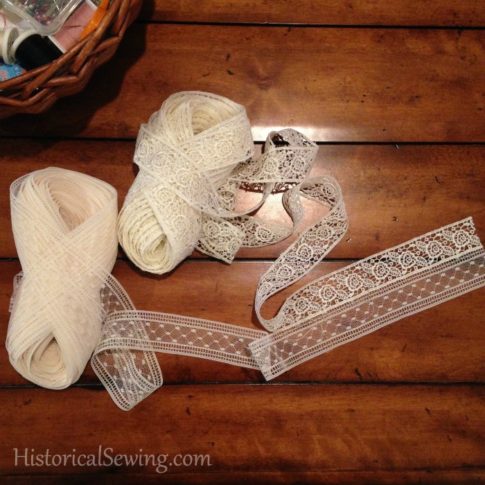
Quite honestly, I don’t collect or hoard lace in my stash. Fabrics, yes. Trims, yes. But not lace.
But I DID happen to find 15 yards of flat rose motif lace I had purchased in Downtown L.A. over ten years ago for trim on an Edwardian suit. Obviously, the suit has not yet been made. So I stole the lace for the dressing gown… hehe.
After drafting the front panels I measured the faux princess seam from shoulder to hem and the center front opening coming to right about 5 yards needed of this main lace placement. That left 10 yards to construct the chevron pattern on both fronts.
It was an exercise in frugality, ingenuity, and prayers that I wouldn’t run short of lace.

My initial thought was to machine the rows of laces together with an edge foot. Ha!
Ha! Ha! Ha!
It took all of about 11 inches to realize the technique would produce an inferior result. So hand sewing it was!! All.ten.yards.of.two.rows.of.net.lace. Two rows because…
As I was studying the original gown and searching for laces, I used the magnificent zoom feature on the Met’s website to get closer looks at those front lace panels. (If you haven’t used that zoom you are missing most wonderful details on garments!)
At first I thought the fabric puffs were actually strips of pleated fabric, not gathered as they truly are. Then I noticed that together with the fabric strips was a nice embroidered trim (where I was using my rose lace) and a narrower net lace. The net lace was placed every-other-row and not just single within the repeat.
Oh! So back to the board to recalculate types of laces and their placement within the panels.
I decided that since I had 20 yards of the net lace with the little lip edging on both sides I had enough to use it double to the one, 10-yard length of the main rose lace I had (after allowing for the five yards for the vertical placements). This made me happy that I was still able to keep to the original with the net lace being every other row.
But… I realized the double use of the net lace AFTER I had already sewed one length of net lace to the rose lace. All ten yards. Oh dear.
I altered the in-progress design by trimming off one side of the lip edging on the net lace to make a narrower row. So the result was as the original gown: rose lace (in place of the embroidered one), net lace, gathered fabric puff, net lace and repeat.

I zoomed-in and studied the front of the gown further to figure out, proportionally, what the fabric puff width would be in regards to the laces. I ended up cutting it 1.5″ wide and straight, not bias. I think I cut about 32 strips, give or take, across the width of the cotton lawn fabric I used for the gown itself.

Again, because time was short, I wanted to run the fabric strips through my machine gathering foot. Yeah… That was a disaster. You can see the mess in the above photo in the bottom strip.
So… crap. I ended up running a single machine basting row along each side and pulling the threads to gather. The strips are gathered up not quite 1.5 times the length. More time spent…. As you can see, though, the result was much better!
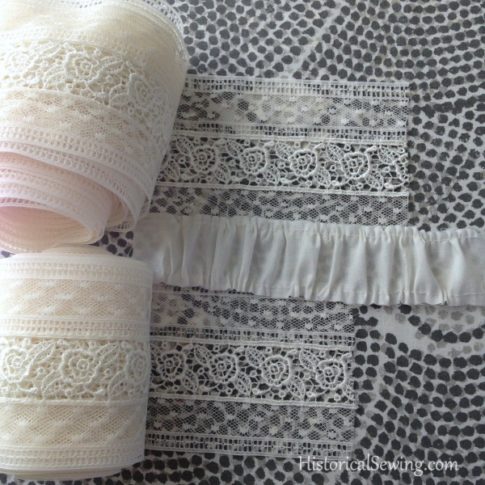
The original gown shows the gathered fabric puff being held down with narrow strips along each side. I figured this was to cover the fabric raw edges as well as add another detail. From what I can see they look to be machine sewn down.
Great! Something I didn’t have to hand sew.
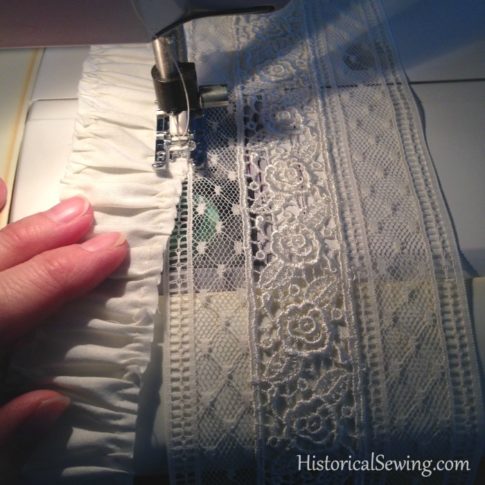
The next step was basting the gathered fabric puffs to the wide lace strips. I used the lip edging on the net lace as my guide. Again, this was along the full 10 yards of previously sewn together laces.

The edging strips were also cut from the cotton lawn. I cut them on the bias and pieced them for at least 20 yards – because the strips had to go down both sides of each puff.
Next I had to press the long strip to create a single fold bias tape. I wanted a tiny 1/8″ width but couldn’t find a tape maker that size in time. So I used a 1/4″ width. It ended up being just fine. After running through the tape maker I wound the pressed yardage over a book to keep it flat.
Up to this point it’s all been prep work. Now to construct the front panels….
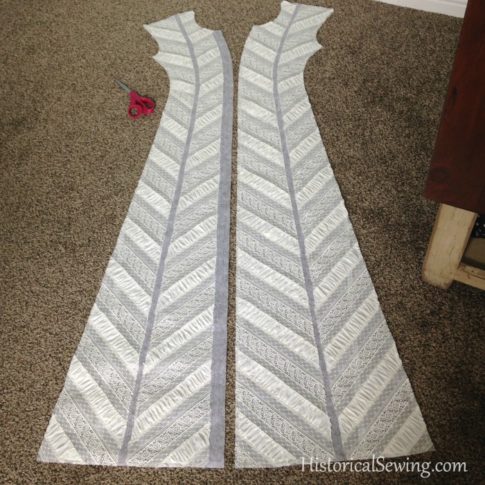
In my thought process of how to even construct this gown I came upon the brilliant idea of using a stabilizer to mount the lace strips onto in the chevron pattern. After altering my pattern following the fitting of my mockup I cut the two front panels out of tear away stabilizer creating templates.
Early on I debated if I should mount single rows of lace and fabric puffs to the templates or sew the lace strips together first then mount. I obviously chose the latter. I figured it would be a little easier to get a better chevron pattern match on each panel but also in relation to left & right panels.
On each template half I drew the main placement lines in the middle of each panel for the vertical placement of rose lace and also the on the right half at center front which covers the hidden placket.

I started mounting the completed lace strip at the bottom, looking at both panels to get the same angle. I then machine basted around the lace strip attaching it to the stabilizer. (I’ve never worked with tear-away stabilizer in this manner before. I had to be careful in handling it so it wouldn’t tear – which only happened to me twice and even then it was on my drawn in lines not next to the actual stitches.)


I worked my way up each panel mounting both halves of the chevron together to create an even pattern. Around the top curve of the princess seam, below the armhole, I had to tweak my direction of the chevron to keep the pattern even up to the shoulder line as seen on the original.

After both panels were mounted with the chevrons my next step was to add the bias tape over the puff raw edges. I did this by machine (as I think the original was that way), and I’ll admit my stitches aren’t perfectly straight along both folded edges. (Part of this was due to the deadline – the event – approaching in about a week and I still had to finish the construction of the gown.)

After all the bias tape pieces were sewn down I added the middle vertical strip of rose lace.
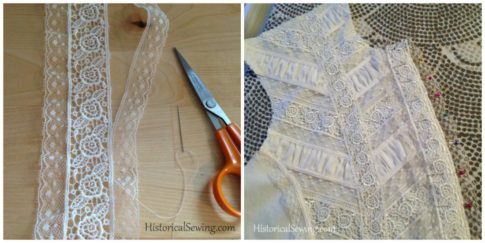
Next I hand sewed edging lace onto both sides of the last strip of rose lace for the placket. I was able to machine stitch this strip of lace to the template.

The last step was to baste the edging lace to the princess seam then stitch the template to the cotton lawn fabric side front panel.
Finally the lace front panels were finished and ready to incorporate into the gown.
The whole front was then flatlined to my underlining fabric which was a basic cotton broadcloth.

Read part 2 – the main gown construction.





I’m trying to decide if I should put some off-white machine lace on the hem of my over-petticoat for a late 19th century outfit. I may have enough though narrow eyelet. I kind of get the feeling that lace wasn’t ‘hidden’ on a petticoat during this time period and especially on this continent. Any opinions?
As the sewing machine picked up in popularity in the 1860s and 1870s the undergarments became more decorated because the machine make dressmaking faster. You’ll see “fancy” petticoats from mid-century onwards. You are perfectly ok to add lace to your petticoat. 🙂
thanks so much!!
This is as fine a piece of master sewing work as I have ever seen. Your Ingenuity is amazing!
Thank you Penny. I was really challenged in how to go about doing it.
Utterly exquisite. I am in awe!
Thank you Elaine!